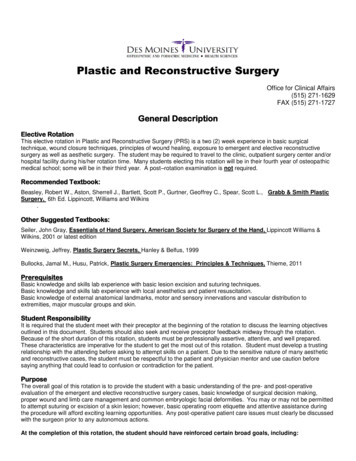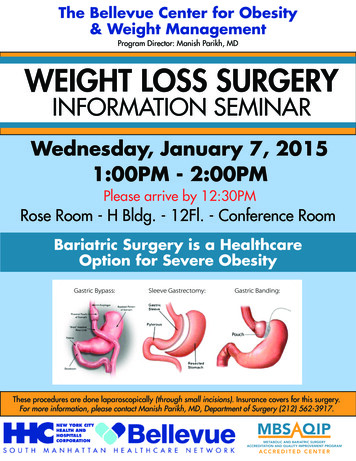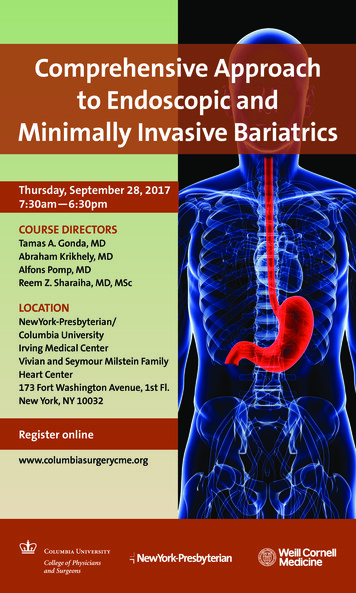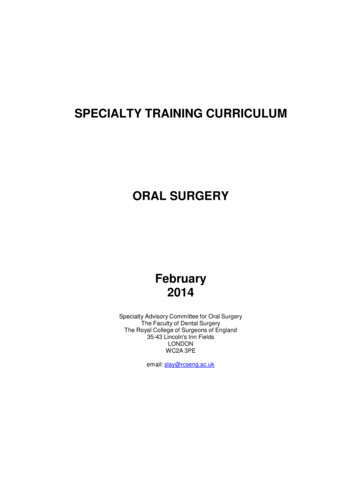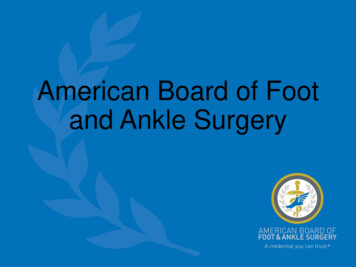
Transcription
TITLESurgery of the Brainstem1st EditionPRICEISBNPUBLICATION DATEFORMATMEDIA CONTENTSPECIALTYLEVELEDITORS 23,1009781626232914November 2019Hardcover · 400 Illustrations · 384 Pages · 9 X 12 INComplimentary MedOne eBook and VideosNeurosurgeryResidents and aboveRobert F. Spetzler, MD, is Emeritus President and CEO, Barrow Neurological Institute, Phoenix, Arizona,USA.M. Yashar S. Kalani, MD, PhD, is Vice Chair and Associate Professor, Director of Skull Base andNeurovascular Surgery, Departments of Neurosurgery and Neuroscience, University of Virginia School ofMedicine, Charlottesville, Virginia, USA.Michael T. Lawton, MD, is President and CEO, Department of Neurosurgery Chair, Barrow NeurologicalInstitute, Phoenix, Arizona, USA.DESCRIPTIONThe ultimate guide to navigating and treating brainstem pathologies from master neurosurgeon RobertSpetzlerThe brainstem is one of the last bastions of surgical prohibition because of its densely packed ascendingand descending tracts and nuclei carrying information to and from the brain. Although 10% of all pediatrictumors and 5% of all vascular anomalies occur in the brainstem, neurosurgeons have traditionally resisteddissecting lesions in this area. Recent advances in imaging, microscopy, anesthesia, and operativetechniques have expanded the treatment paradigm for this most eloquent region of the brain.Surgery of the Brainstem, by internationally renowned neurosurgeons Robert F. Spetzler, M. Yashar S.Kalani, and Michael T. Lawton, along with an impressive cadre of global experts, is a comprehensive guideto managing disorders of the brainstem, thalamic region, and basal ganglia. Organized in seven sectionswith 33 chapters, the text opens with four sections covering a variety of topics. Section I presents thehistory of brainstem surgery; Section II examines anatomy, development, and pathology; Section IIIreviews patient examination, imaging, and monitoring; and Section IV provides a succinct overview ofsurgical approaches. Sections V-VII cover a wide range of adult and pediatric tumors, ischemia, stroke,aneurysms, arteriovenous malformations, and cerebral cavernous malformations. More than 400 highquality clinical images, medical illustrations, and online videos enhance the text.Key Highlights A full spectrum of treatment modalities and outcomes, including open surgery, endoscopicapproaches, stereotactic radiosurgery, radiotherapy, endovascular techniques, andrevascularizationAn anatomy chapter featuring stunning Rhoton-style anatomical dissections delineates criticallandmarks in the brainstem, thalamus, pineal region, and cranial nervesDetailed discussion of patient positioning and exposure of various brainstem domains
Pearls on overcoming psychological, pathological, and anatomical barriers and managingcomplicationsUnderstanding the basic anatomy, pathology, and clinical complexities of the brainstem and thalamicregions is essential for safe navigation and treatment. This remarkable book will provide neurosurgeonswith additional insights on performing resections and achieving the best possible outcomes for patientswith pathologic conditions in this delicate region.This book includes complimentary access to a digital copy on https://medone.thieme.com.COMPETITIONThere is no direct competition outside of Thieme books.CONTENTSSection I: History of Brainstem SurgeryChapter 1: History of Brainstem SurgerySection II: Anatomy, Development, and Pathology of the Brainstem, Thalamus, and Pineal RegionChapter 2: Anatomy of the Brainstem, Thalamus, Pineal Region, and Cranial NervesChapter 3: Development of the Human Brainstem and Its VasculatureChapter 4: Pathology of the BrainstemSection III: Examination, Imaging, and Monitoring for Brainstem SurgeryChapter 5: Imaging Anatomy and Pathology of the Brainstem, Thalamus, and Pineal RegionChapter 6: Neuromonitoring for Brainstem SurgeryChapter 7: Neurologic Examination of the Brainstem and ThalamusSection IV: Surgical Approaches to the Brainstem, Thalamus, and Pineal RegionChapter 8: Surgical Approaches to the Ventral Brainstem and ThalamusChapter 9: Approaches to the Dorsal Brainstem, Thalamus, and Pineal RegionChapter 10: Skull Base Approaches to the Lateral Brainstem and Cranial NervesChapter 11: Endoscopic Approaches to the BrainstemChapter 12: Safe Entry Zones to the BrainstemSection V: Comprehensive Management of Tumors of the Brainstem, Thalamus, and Pineal RegionChapter 13: Adult Brainstem GliomasChapter 14: Pediatric Brainstem TumorsChapter 15: Tumors of the ThalamusChapter 16: Tumors of the Third VentricleChapter 17: Tumors of the Fourth VentricleChapter 18: Tumors of the Cerebellopontine AngleChapter 19: Pineal Region TumorsChapter 20: Stereotactic Radiosurgery for Tumors of the Brainstem, Thalamus, and Pineal RegionChapter 21: Radiotherapy for Pineal, Thalamic, and Brainstem TumorsChapter 22: Neuro-Oncologic Considerations for Pineal, Thalamic, and Brainstem TumorsSection VI: Comprehensive Management of Vascular Pathology of the Brainstem and ThalamusChapter 23: Brainstem Ischemia, Stroke, and Endovascular Revascularization of the Posterior CirculationChapter 24: Microsurgical Embolectomy for Emergency Revascularization of the BrainstemChapter 25: Brainstem and Thalamic Intraparenchymal HemorrhageChapter 26: Surgical Management of Posterior Circulation AneurysmsChapter 27: Endovascular Management of Aneurysms of the Posterior CirculationChapter 28: Surgical Management of Thalamic and Brainstem Arteriovenous MalformationsChapter 29: Endovascular Management of Brainstem and Thalamic Arteriovenous MalformationsChapter 30: Surgery for Thalamic and Brainstem Cavernous MalformationsChapter 31: Revascularization of the BrainstemChapter 32: Stereotactic Radiosurgery for AVMs of the Basal Ganglia, Thalamus, and BrainstemSection VII: Implants and Cranial Nerve RepairChapter 33: Auditory Brainstem Implants
TITLENeurosurgery Case Review: Questions andAnswers2nd EditionPRICEISBNPUBLICATION DATEFORMATMEDIA CONTENTSPECIALTYLEVELEDITORS 13,3009781626231986 (Previous Edition: 9781604060522, 2009)March 2020Softcover · 450 Illustrations · 597 Pages · 8.5 X 11 INComplimentary MedOne eBookNeurosurgeryResidentsRemi Nader, MD, CM, FRCSC, FACS, FAANS, is Founder and President, Texas Center for Neurosciencesand International Center for Neuroscience, and Chairman, Department of Neurosurgery, United GeneralHospital, Houston, Texas; and Adjunct Clinical Professor of Neurosurgery, University of Texas MedicalBranch, Galveston, Texas, USA.Abdulrahman J. Sabbagh, MBBS, FRCSC, is Head of the Research and Development Unit, Clinical Skilland Simulation Center; and Assistant Professor, Consultant Neurosurgeon, Consultant Pediatric andEpilepsy Neurosurgeon, King Abdul Aziz University, Jeddah Governorate, Saudi Arabia.Samer K. Elbabaa, MD, is a Medical Director and Pediatric Neurosurgery Director, Arnold Palmer Hospitalfor Children; and Professor of Neurosurgery, College of Medicine, University of Central Florida, Orlando,Florida, USA.Hosam Al-Jehani, MBBS, MSc, FRCSC, is Assistant Professor and Consultant of Neurosurgery,Interventional Neuroradiology, and Neurocritical Care, King Fahd Hospital of the University at ImamAbdulrahman Bin Faisal University, Alkhobar; and Director of the Neurosciences Service Line, EP-1 Cluster,Dammam, Saudi Arabia.Jaime Gasco, MD, FAANS, FEBNS, is a Neurosurgeon, Department of Neurosurgery, University MedicalCenter of El Paso, El Paso, Texas, USA.Cristian Gragnaniello, MD, PhD, MSurg, MAdvSurg, FICS, is a Neurosurgeon, Department ofNeurosurgery, University of Illinois at Chicago, Chicago, Illinois, USA.DESCRIPTIONNeurosurgical vignettes in question and answer format provide robust prep for the ABNS oral exam!Neurosurgery Case Review: Questions and Answers, 2nd Edition by Remi Nader, Abdulrahman Sabbagh,Samer Elbabaa, Hosam Al-Jehani, Jaime Gasco, and Cristian Gragnaniello provides a robust study guide forthe American Board Neurological Surgery and the Royal College of Physicians and Surgeons of Canadaoral board examinations. The second edition expands on the highly successful first edition, presenting149 cases commonly encountered by neurosurgeons in clinical practice.The cases are broadly divided into seven sections—tumor, vascular intracranial pathology, trauma,pediatric, functional, spine, and peripheral nerves. The chapters are arranged in a manner that mirrors theoral board exam. Each case includes a brief clinical scenario followed by questions on presentation,diagnosis, imaging, management, surgical detail, complications, and outcome. The presentedinformation is backed by the latest available evidence-based references and data.
Key Features: Contributions from internationally renowned neurosurgical educatorsDetailed answers enhance readers' knowledge and provide guidance on how to respond toquestions asked in the oral board examsMore than 430 high-quality images, many in full color, ensure visual understanding of keyconceptsSuggested readings at the end of cases offer additional study resourcesThis is an indispensable, one-stop resource for neurosurgical residents and fellows prepping for the ABNSand Royal College oral board examinations. Neurosurgeons studying for recertification will also find thisbook an invaluable reference for rapid review.This book includes complimentary access to a digital copy on https://medone.thieme.com.COMPETITION100 Case Reviews in Neurosurgery, Jandial,2017, Elsevier, 624pp, 99.99.Goodman's Neurosurgery Oral Board Review, Levi, 2017, OUP, 192pp, 93.Related Thieme titles: CONTENTSHarbaugh, Neurosurgery Knowledge Update, 984 pages, 2015, 254.99Citow, Neurosurgery Oral Board Review, 3e, 703 pages, 2019, 159.99 (bundled with MedOne eBook)Part 1 Intracranial Pathology: Tumors1 Vestibular Schwannoma in Neurofibromatosis Type 22 Subependymal Giant Cell Astrocytomas (SEGA)3 Sturge-Weber Syndrome4 Von Hippel–Lindau Disease—Hemangioblastoma5 Parasagittal Meningioma6 Tuberculum Sellae meningioma7 Olfactory Groove Meningioma8 Sphenoid Wing Meningioma9 Hemangiopericytoma10 Anterior Clinoidal Meningioma11 Velum Interpositum Meningioma12 Pituitary Apoplexy13 Secreting Pituitary Lesion14 Non-Functioning Pituitary Adenoma15 Craniopharyngioma: Endoscopic Approach16 High Grade Glioma – Surgical Treatment17 High Grade Glioma – Epigenetics18 Eloquent Cortex Low Grade Glioma19 Brain Metastasis20 Meningeal Carcinomatosis21 Primary Central Nervous System Lymphoma22 Fibrous Dysplasia of the Skull23 Orbital Tumor24 Multiple Ring-Enhancing Cerebral Lesions25 Paraganglioma26 Colloid Cyst of the Third Ventricle27 Central Neurocytoma28 Clival Chordoma
29 Petrous Apex Tumor30 Intracranial ChondrosarcomaPart 2 Intracranial Pathology: Vascular31 Dural Arteriovenous Fistula32 Cerebral Arteriovenous Malformation33 Supratentorial Cavernous Angioma34 Brainstem Vascular Lesions35 Carotid Cavernous Sinus Fistulas36 Subarachnoid Hemorrhage and Vasospasm37 Posterior Communicating Artery Aneurysm38 Middle Cerebral Artery Aneurysm with Intracerebral Hemorrhage39 Distal Anterior Cerebral Artery Aneurysm40 Blister Carotid Aneurysm41 Basilar Tip Aneurysms42 Vertebrobasilar Junction Aneurysms43 Concomitant Arteriovenous Malformation and Aneurysm44 Stent and Balloon Assisted Coiling45 Balloon Test Occlusion and Giant Aneurysm46 Ischemic Stroke Initial Management47 Decompressive Craniectomy for Ischemic Stroke48 Adult Moyamoya49 Hypertensive Putaminal Hematoma50 Cerebellar Hemorrhage51 Amaurosis Fugax with Carotid Occlusion52 Tandem Extracranial and Intracranial Carotid Stenosis53 Vertebral Artery Stenosis with Ischemia54 High-Grade Carotid Stenosis and Intracranial AneurysmPart 3 Trauma55 Chronic Subdural Hematoma56 Mild Head Injury57 Epidural Hematoma58 Traumatic Acute Subdural Hematoma59 New Trends in Neurotrauma Monitoring60 Intracranial Pressure Management61 Gunshot Wound Injury to the Head62 Other Penetrating Intracranial TraumaPart 4 Pediatric63 Aqueductal Stenosis64 Cerebrospinal Fluid Shunt Infections65 Slit Ventricle Syndrome66 Mega-hydrocephalus67 Cerebellar Medulloblastoma68 Brainstem Glioma 1 — Pons69 Pineal Region Tumors70 Posterior Fossa Ependymoma71 Neurofibromatosis Type 172 Hypothalamic Hamartoma73 Posterior Fossa Juvenile Pilocytic Astrocytoma74 Vein of Galen Malformation75 Pediatric Head Trauma76 Pediatric Intracranial Epidural Abscess77 Spontaneous Cerebrospinal Fistula78 Cerebral Palsy and Selective Dorsal Rhizotomies79 Neural Tube Defect80 Idiopathic Syringomyelia in Children and Adolescents
81 Tethered Cord Syndrome82 Positional Plagiocephaly83 Scaphocephaly – Open Repair84 Scaphocephaly – Endoscopic RepairPart 5 Functional85 Tic Douloureux86 Hemifacial Spasm87 Postherpetic Neuralgia88 Complex Regional Pain Syndrome (CRPS) In Children89 Spasticity after Cord Injury90 Neuronavigation and Intraoperative Imaging91 Deep Brain Stimulation: Parkinson's Disease92 Deep Brain Stimulation: Essential Tremor93 Deep Brain Stimulation: Dystonia94 Temporal Lobe Epilepsy95 Hemispherectomy96 Corpus Callosotomy for Drop Attacks97 Vagal Nerve Stimulator98 Idiopathic Intracranial Hypertension99 Normal Pressure HydrocephalusPart 6 Spine100 Occipital Condyle Fractures101 Jefferson Fractures102 Hangman's Fracture103 Atlantoaxial Instability104 Type 2 Odontoid Fracture105 Basilar Invagination106 Central Cord Syndrome / Cord Contusion107 Lower Cervical Fracture Dislocation108 Thoracic Compression Fracture with Neurological Deficit109 Thoracolumbar Fracture-Dislocation With Complete Spinal Cord Injury110 Disc Disruption and Ligamentous Injury111 Lumbar Burst Fracture112 Lumbar Chance Fracture113 Gunshot Injuries to the Spine114 Spinal Cord Injury without Radiologic Abnormality (SCIWORA)115 Acute Cervical Disc Herniation116 Anterior versus Posterior Approaches to the Cervical Spine117 Ossification of the Posterior Longitudinal Ligament118 Thoracic Disk Herniation119 Thoracolumbar Scoliosis120 Lower Back Pain – Conservative Management121 Lumbar Disc Herniation122 Black Disk with Advanced Modic Changes123 Neurogenic versus Vascular Claudications124 Cauda Equina Syndrome125 Lumbar Spondylosis with Facet Hypertrophy126 Degenerative Spondylolisthesis127 Sacroiliac Joint Dysfunction SIJ Fusion128 Intradural Spinal Tumor129 Intramedullary Spinal Tumor130 Spinal Metastases131 Lumbar Vertebral Mass132 Cervical Spine Mass133 Spinal Arteriovenous Malformation
134 Spinal Arteriovenous Fistula135 Spinal Epidural Abscess136 Vertebral Osteomyelitis and Diskitis137 Spinal Cord Inflammatory Disorder138 Chiari I MalformationPart 7 Peripheral Nerve139 Median Nerve Entrapment at the Wrist140 Ulnar Nerve Compression at the Elbow141 Neurogenic Thoracic Outlet Syndrome142 Brachial Plexus Injury and Horner Syndrome143 Median Nerve Laceration at the Wrist (Spaghetti Wrist)144 Radial Nerve Injury145 Axillary Mass146 Medial Arm Mass147 Lower Extremity Peripheral Nerve Sheath Tumor148 Foot Drop and Peroneal Nerve Injury149 Gunshot Injury to the Sciatic Nerve
TITLEVertebral AugmentationThe Comprehensive Guide to Vertebroplasty,Kyphoplasty, and Implant Augmentation1st EditionPRICEISBNPUBLICATION DATEFORMATMEDIA CONTENTSPECIALTYLEVEL 13,3009781684200153April 2020Hardcover · 524 Illustrations · 300 Pages · 8.5 X 11 INComplimentary MedOne eBook and VideosNeurosurgery, Orthopaedic Surgery, Physical Therapy, RadiologyResidents and aboveEDITORSDouglas P. Beall, MD, is Chief of Services, The Spine Fracture Institute at Summit Medical CenterOklahoma, Oklahoma City, Oklahoma, USA.DESCRIPTIONThe definitive guide to performing vertebroplasty, kyphoplasty, and implant augmentation fromnational and international expertsVertebral compression fractures (VCFs) result from trauma or pathologic weakening of the bone and areassociated with conditions such as osteoporosis or malignancy. Worldwide, VCFs impact one in threewomen and one in eight men aged 50 and older, with more than 8.9 million fractures incurred annually.Copublished by Thieme and the Society of Interventional Radiology, Vertebral Augmentation: TheComprehensive Guide to Vertebroplasty, Kyphoplasty, and Implant Augmentation provides a practical, clinicaldiscussion of these minimally invasive spine interventions.Written and edited by Douglas Beall along with associate editors Allan Brook, M. R. Chambers, JoshuaHirsch, Alexios Kelekis, Yong-Chul Kim, Scott Kreiner, and Kieran Murphy, this richly illustrated bookpresents a multidisciplinary and international perspective. It features contributions from renownedexperts in interventional radiology, neurosurgery, pain medicine, and physiatry. This resource fills a gap inthe literature, with extensive updates on a vast amount of new information and techniques that havebeen introduced during the past decade. Thirty-five chapters address treatment of spine fractures,starting with a history and introduction to vertebral augmentation, discussion of VCFs, patientassessments, physical exam findings, pain management, and much more.Key Features Procedural chapters cover vertebroplasty, sacroplasty, cervical and posterior arch augmentation,balloon kyphoplasty, and vertebral augmentation with implants and for challenging pathologiesSpecial topics include radiation exposure and protection, post-procedure physical therapy,osteoporosis treatment, postural fatigue syndrome, the effect on morbidity and mortality, andcementoplasty outside the spineTreatment of complex cases are also discussed extensively, including chronic vertebralcompression fractures, neoplastic vertebral compression fractures, instrumented spinal fusions,and severe benign and malignant fracturesThe final chapter features 16 subchapters from global masters of vertebral augmentation, withpersonal tips, tricks, and pearls they use in their own practices
This is a must-have resource for interventional radiology, neurosurgery, interventional pain management,and orthopaedic surgery residents and fellows, as well as seasoned clinicians who wish to incorporatethese procedures into practice.This book includes complimentary access to a digital copy on https://medone.thieme.com.COMPETITIONMathis, Percutaneous Vertebroplasty and Kyphoplasty, 2nd ed.,309 pages, Springer, 2006, 259.CONTENTS1 History and Introduction to Vertebral Augmentation2 Vertebral Compression Fractures3 Preprocedure Assessment Prior to Vertebral Augmentation4 Physical Examination Findings in Patients with Vertebral Compression Fractures5 Medical Pain Management in Patients with Vertebral Compression Fractures6 Approaches to the Vertebral Body7 Properties of Bone Cements and Vertebral Fill Materials: Implications for Clinical Use in Image-GuidedTherapy and Vertebral Augmentation8 Vertebroplasty9 Sacroplasty: Management of Sacral Insufficiency Fractures10 Cervical and Posterior Arch Augmentation11 Balloon Kyphoplasty12 Vertebral Augmentation with Implants13 Radiation Exposure and Protection: A Conversation Beyond the Inverse Square Law,Thermoluminescent Dosimeters, and Lead Aprons14 Appropriateness Criteria for Vertebral Augmentation15 Literature Analysis of Vertebral Augmentation16 Cost-Effectiveness of Vertebral Augmentation17 Additional and Adjacent Level Fractures after Vertebral Augmentation18 Predisposing Factors to Vertebral Fractures19 Bracing for Spinal Fractures20 Amount of Cement or Vertebral Fill Material for Optimal Treatment and Pain Relief21 Clinical Presentation and the Response to Vertebral Augmentation22 Effect of Vertebral Augmentation on Morbidity and Mortality23 Number of Levels Appropriately Treated with Vertebral Augmentation24 Pain after Vertebral Augmentation25 Postural Fatigue Syndrome26 Physical Therapy after Vertebral Augmentation27 Sham vs. Vertebral Augmentation28 Treatment of Chronic Vertebral Compression Fractures29 Treatment of Neoplastic Vertebral Compression Fractures30 Vertebral Augmentation in Instrumented Spinal Fusions31 Biomechanical Changes after Vertebral Compression Fractures32 Advanced Principles of Minimally Invasive Vertebral Body Stabilization in Severe Benign and MalignantFractures: Stent-Screw Assisted Internal Fixation33 Cementoplasty Outside the Spine34 Treatment of Osteoporosis after Vertebral Augmentation35 Miscellaneous Tips by the Masters of Vertebral Augmentation
TITLEPRICEISBNPUBLICATION DATEFORMATMEDIA CONTENTSPECIALTYLEVELEDITORSNeurosurgery Outlines1st Edition 5,4009781684201426June 2020Softcover · 349 Illustrations · 348 PagesComplimentary MedOne eBookNeurosurgeryMedical Students, Residents and NursesPaul E. Kaloostian, MD, FAANS, FACS, is Assistant Professor of Neurosurgery, University of California,Riverside, School of Medicine, Riverside, California, USAChrist Ordookhanian, BS, MD Candidate, is University of California, Riverside, School of Medicine,Riverside, California, USADESCRIPTIONPocket-size, user-friendly roadmap outlines most common surgical procedures in neurosurgery!Surgery requires a combination of knowledge and skill acquired through years of direct observation,mentorship, and practice. The learning curve can be steep, frustrating, and intimidating for many medicalstudents and junior residents. Too often, books and texts that attempt to translate the art of surgery arefar too comprehensive for this audience and counterproductive to learning important basic skills tosucceed. Neurosurgery Outlines by neurosurgeon Paul E. Kaloostian is the neuro-surgical volume in theSurgical Outlines series of textbooks that offer a simplified roadmap to surgery.This unique resource outlines key steps for common surgeries, laying a solid foundation of basicknowledge from which trainees can easily build and expand. The text serves as a starting point forlearning neurosurgical techniques, with room for adding notes, details, and pearls collected during thejourney. The chapters are systematically organized and formatted by subspecialty, encompassing spine,radiosurgery, brain tumors and vascular lesions, head trauma, functional neurosurgery, epilepsy, pain,and hydrocephalus. Each chapter includes symptoms and signs, surgical pathology, diagnostic modalities,differential diagnosis, treatment options, indications for surgical intervention, step-by-step procedures,pitfalls, prognosis, and references where applicable.Key Features COMPETITIONN/AProvides quick procedural outlines essential for understanding procedures and assistingattending neurosurgeons during roundsSpine procedures organized by cervical, thoracic, lumbar, sacral, and coccyx regions covertraumatic, elective, and tumor/vascular-related interventionsCranial topics include lesion resection for brain tumors and cerebrovascular disease and TBItreatment
CONTENTS1. Section I: Spine1 Cervical2 Thoracic3 Lumbar4 Sacral5 CoccyxSection II: Radiosurgery/CyberKnife Treatment6 Spinal Radiosurgery7 Cranial RadiosurgerySection III: Cranial Lesion Resection (Brain Tumor, Vascular Lesions)8 Brain Tumors9 Cerebral Vascular LesionsSection IV: Cranial Trauma10 Epidural Hematoma Evacuation/Subdural Hematoma Evacuation/Intracerebral HemorrhageEvacuation11 Hemicraniectomy (Unilateral, Bilateral, Bifrontal versus Frontotemporal)12 Cranioplasty13 Placement of External Ventricular Drain/Placement of Intraparenchymal ICP MonitorSection V: Functional Neurosurgery14 Deep Brain StimulationSection VI: Epilepsy15 Subdural Grid Placement16 AmygdalohippocampectomySection VII: Pain Management Strategies17 Spinal Cord Stimulator18 Baclofen Pump/Morphine PumpSection VIII: Hydrocephalus Treatment19 Ventriculoperitoneal Shunt20 Lumboperitoneal Shunt21 Ventriculopleural Shunt22 Ventriculoatrial Shunt
TITLEBotulinum Neurotoxin for Head and NeckDisorders2nd EditionPRICEISBNPUBLICATION DATEFORMATMEDIA CONTENTSPECIALTYLEVELEDITORS 11,8009781684200955 (Previous Edition: 9781604065855, 2012)May 2020Hardcover · 95 Illustrations · 226 Pages · 7 X 10 INComplimentary MedOne eBook and VideosNeurology, Otolaryngology, Plastic SurgeryResidents, fellows, and practitionersAndrew Blitzer, MD, DDS, FACS, is Professor Emeritus of Otolaryngology–Head and Neck Surgery,Columbia University College of Physicians and Surgeons; Adjunct Professor of Neurology, Icahn School ofMedicine at Mt. Sinai; Director, NY Center for Voice and Swallowing Disorders; and Co-Founder andDirector of Research, ADN International, New York, New York, USA.Brian E. Benson, MD, FACS, is Chairman, Department of Otolaryngology–Head and Neck Surgery,Hackensack Meridian School of Medicine, Hackensack, New Jersey, USA.Diana N. Kirke, MBBS, MPhil, FRACS, is Assistant Professor, Department of Otolaryngology–Head andNeck Surgery, Icahn School of Medicine at Mount Sinai, New York, New York, USA.DESCRIPTIONThe most comprehensive, state-of-the-art guide available on the use of botulinum neurotoxin for head& neck disorders!Senior author Andrew Blitzer is an internationally renowned pioneer on the use of botulinum neurotoxinfor functional disorders, with unparalleled expertise on this topic. Joined by esteemed co-editors BrianBenson and Diana Kirke, with multidisciplinary contributors, Botulinum Neurotoxin for Head and NeckDisorders Second Edition fills a gap in the medical literature. The unique textbook focuses on the use ofbotulinum neurotoxins for functional disorders of the head and neck, though with some aestheticindications. The second edition reflects the latest advances and understanding of existing and emergingapplications for botulinum neurotoxins, including new treatment paradigms, revised pharmacology, andan updated review of the literature in all chapters.Twenty superbly illustrated chapters cover the management of hyperfunctional, pain, and hypersecretorysyndromes of the head and neck. Hyperfunctional motor disorders are discussed in chapters focused onblepharospasm, facial dystonia, Meige syndrome, oromandibular dystonia, spasmodic dysphonia(laryngeal dystonia), and cervical dystonia. Specific treatment approaches for pain are addressed inchapters on migraine and chronic daily tension headaches, temporomandibular disorders, and trigeminalneuralgia. The treatment of autonomic nervous system disorders is covered in chapters dedicated to Freysyndrome, facial hyperhydrosis, and sialorrhea.Key Features A 30-year review of spasmodic dysphonia data includes new insights encompassingcomprehensive treatment, management and outcomes results, and neuropathophysiologyA new chapter details the emerging role of botulinum neurotoxin to treat radiation-inducedspasm and pain
Updates on the management of palatal myoclonus, temporomandibular joint disorder, andsialorrheaAn impressive compendium of professional injection videos, including a new video on sialorrheaand an updated migraine videoClinical pearls throughout the book focus on best practices, how to avoid pitfalls, and achievingthe most optimal outcomesThis is a must-have resource for otolaryngologists–head and neck surgeons, neurologists, dentists, painspecialists, physical medicine and rehabilitation specialists, and others health professionals who usebotulinum neurotoxin to treat motor, sensory, and autonomic disorders of the head and neck region.This book includes complimentary access to a digital copy on https://medone.thieme.com.COMPETITIONAlter, Botulinum Neurotoxin Injection Manual, 200 pages, Demos/Springer, 2015, 75.Truong, Manual of Botulinum Toxin Therapy, 2e, 315 pages, 2014, 127, CUP.CONTENTSChapter 1: Pharmacology of Botulinum NeurotoxinsChapter 2: Botulinum Neurotoxin for BlepharospasmChapter 3: Botulinum Neurotoxin for Facial DystoniaChapter 4: Botulinum Neurotoxin for Meige SyndromeChapter 5: Botulinum Neurotoxin for Oromandibular DystoniaChapter 6: Botulinum Neurotoxin for Spasmodic DysphoniaChapter 7: Botulinum Neurotoxin for Cervical DystoniaChapter 8: Botulinum Neurotoxin for Hemifacial Spasm and Facial SynkinesisChapter 9: Botulinum Neurotoxin for Hyperfunctional Facial LinesChapter 10: Botulinum Neurotoxin for Upper and Lower Esophageal SpasmChapter 11: Botulinum Neurotoxin for Palatal MyoclonusChapter 12: Botulinum Neurotoxin for Temporomandibular Disorders, Masseteric Hypertrophy, andCosmetic Masseter ReductionChapter 13: Botulinum Neurotoxin Therapy in the LaryngopharynxChapter 14: Botulinum Neurotoxin for MigraineChapter 15: Botulinum Neurotoxin for Chronic Tension HeadacheChapter 16: Botulinum Neurotoxin for Trigeminal NeuralgiaChapter 17: Botulinum Neurotoxin for Frey's SyndromeChapter 18: Botulinum Neurotoxin for Facial HyperhidrosisChapter 19: Botulinum Neurotoxin for SialorrheaChapter 20: Botulinum Neurotoxin for Radiation-Induced Spasm and Pain
TITLEIncidental Findings in Neuroimaging andTheir ManagementA Guide for Radiologists, Neurosurgeons, andNeurologists1st EditionPRICEISBNPUBLICATION DATEFORMATMEDIA CONTENTSPECIALTYLEVELEDITORS 13,3009781626238282June 2020Hardcover · 799 Illustrations · 302 Pages · 8.5 X 11 INComplimentary MedOne eBookNeurology, Neurosurgery, RadiologyResidents, medical professionalsKaye D. Westmark, MD, is Clinical Assistant Professor, Department of Diagnostic and InterventionalImaging, University of Texas Medical School, Houston, Texas, USA.Dong H. Kim, MD, is Professor and Chair, Vivian L. Smith Department of Neurosurgery, University ofTexas Health Science Center; and Director, Mischer Neuroscience Institute, Memorial Hermann-TexasMedical Center, Houston, Texas, USA.Roy F. Riascos, MD, is Professor of Radiology and Neurosurgery, McGovern Medical School, University ofTexas, Chief of Neuroradiology, and Director, Center for Advanced Imaging Processing, MemorialHermann-Texas Medical Center, Houston, Texas, USA.DESCRIPTIONA multidisciplinary guide to managing incidental findings in neuroimaging from top expertsIncidental Findings in Neuroimaging and Their Management: A Guide for Radiologists, Neurosurgeons, andNeurologists presents a streamlined, case-based approach to 50 commonly seen incidental findings inneuroimaging. Edited by Kaye Westmark, Dong Kim, and Roy Riascos, this uniq
Citow, Neurosurgery Oral Board Review, 3e, 703 pages, 2019, 159.99 (bundled with MedOne eBook) CONTENTS Part 1 Intracranial Pathology: Tumors 1 Vestibular Schwannoma in Neurofibromatosis


